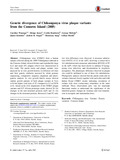Genetic divergence of Chikungunya virus plaque variants from the Comoros Island (2005).

View/
Date
2015-08Author
Wasonga, C
Inoue, S,
Rumberia, C
Michuki, G
Kimotho, J
Ongus, JR
Sang, R
Musila, L
Language
enMetadata
Show full item recordAbstract
Chikungunya virus (CHIKV) from a human sample collected during the 2005 Chikungunya outbreak in the Comoros Island, showed distinct and reproducible large (L2) and small (S7) plaques which were characterized in this study. The parent strain and plaque variants were analysed by in vitro growth kinetics in different cell lines and their genetic similarity assessed by whole genome sequencing, comparative sequence alignment and phylogenetic analysis. In vitro growth kinetic assays showed similar growth patterns of both plaque variants in Vero cells but higher viral titres of S7 compared to L2 in C6/36 cells. Amino acids (AA) alignments of the CHIKV plaque variants and S27 African prototype strain, showed 30 AA changes in the non-structural proteins (nsP) and 22 AA changes in the structural proteins. Between L2 and S7, only two AAs differences were observed. A missense substitution (C642Y) of L2 in the nsP2, involving a conservative AA substitution and a nonsense substitution (R524X) of S7 in the nsP3, which has been shown to enhance O'nyong-nyong virus infectivity and dissemination in Anopheles mosquitoes. The phenotypic difference observed in plaque size could be attributed to one of these AA substitutions. Phylogenetic analysis showed that the parent strain and its variants clustered closely together with each other and with Indian Ocean CHIKV strains indicating circulation of isolates with close evolutionary relatedness in the same outbreak. These observations pave way for important functional studies to understand the significance of the identified genetic changes in virulence and viral transmission in mosquito and mammalian hosts.
Citation
Virus Genes. 2015 Sep 7.Publisher
University of Nairobi
